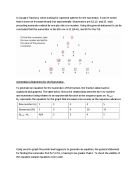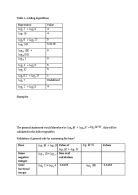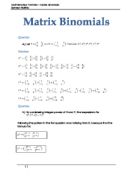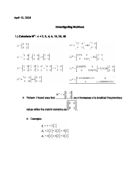Lascap Fractions. In Lacsap's Fractions, when looking for a general pattern for the numerator, it can be noted that it does not increase linearly but exponentially
In Lacsap's Fractions, when looking for a general pattern for the numerator, it can be noted that it does not increase linearly but exponentially. Numerators are 3,6,10, and 15, each preceding numerator added by one plus the row number. Using this general statement it can be concluded that the numerator in the 6th row is 21 (15+6), and 28 for the 7th. Generating a Statement for the Numerator: To generate an equation for the numerator of the fraction, the fraction data must be organized and graphed. The table below shows the relationship between the row number and numerator being relative to an exponential function as the sequence goes on. N(n+1)-Nn represents the equation for the graph that increases more evenly as the sequence advances. Using excel to graph the points and loggerpro to generate an equation, the general statement for finding the numerator N=0.5n2+0.5n, n having to be greater than 0. To check the validity of the equation sample equations were used: Sample Equation: 5th Row: N=0.5(5)2+0.5(5)=15 Patterns Recognized: The first pattern that could be recognized is that the difference between the numerators of the ensuing rows is 1 more than the change between the previous numerator of the two consecutive rows. The formula that represents the pattern of how to find the numerator is N(n+1)-N(n)=N(n)-N(n-1)+1. Using this method, the 6th and 7th rows can
Investigating types of logarithms
Table 1: Adding logarithms Expression Value + 4 4 + 5 5.0118 + 0 0 + 5 5 + 1 Undefined + 4 Examples The general statement would therefore be =, this will be validated in the following tables Validation of general rule by examining the base* Base Value of Values Same negative integer Non-real calculation Same fractional integer -6.6438 -6.6438 Same irrational interger 10 10 Different positive integer 4.2146 4.8613 3.7625 Zero Undefined Undefined *? is used to represent any value Validation of general rule through the examination of the number while keeping the bases the same positive integer Number Value of Value of Different positive integer 4.8613 4.8613 Same positive integer 4 4 1 Negative positive Non-real calculation Both negative integers Non-real calculation Different fractional integer -0.7075 -0.7075 Same fractional integer -0.4150 -0.4150 Additive Inverses i.e. 5 + (-5) = 0 Non-real calculation Different irrational number 0.7153 0.7153 Same irrational number 0.4306 0.4306 Number is 0 Undefined Number is 0 0 It is important to take note of the scope and limitations of the general statement, to find out in what condition the general statement does and does not work. = The base cannot be negative, must be above zero, but cannot equal to 1. The number cannot be negative, must be
Logarthimic Patterns
=- Describe how to obtain the third answer in each row from the first two answers. Create two more examples that fit the pattern above. In order to obtain the answer of the third logarithm, the product of the first and second logarithms must be divided by the sum of the answers of the first and second logarithms. Two other examples that fit the pattern above: Let and . Find the general statement that expresses , in terms of c and d. The general statement that expresses is: To test this statement substitute the values of a, x, and c for the values a= 2, b=4, and x= 256: Thus, Scopes and/or limitations of a, b, and x . a > 0, b > 0 The base of a logarithmic equation has to be greater than zero thus, a has to be greater than 0 and b has to be greater than 0. 2. ab1 The base of a logarithmic equation cannot be one because any argument to the base 1 is undefined. If you take an equation such as and by using the change of base formula we get . The natural log of 1 is 0, thus this equation is undefined because the denominator is 0. For example, If we let a=4 and let b= and let x=64 in the follow logarithmic equations: and , then by substituting all the values of a, b, and x we get: . Thus, by using the equation , and substituting the
BMI portfolio sl
Math Portfolio: Body Mass Index Heikki Suomalainen 0.10.2008 Body mass index is acquired by dividing one's weight with the square of his/her height. In the following I will examine what sort of function could be used to predict and present the change in female's body mass index.Graph 1 The following table (Table 1) gives the median BMI for females from two to twenty years of age from United States (2000). Graph 1 presents the data from Table 1 in graphical form. Age is positioned on the X-axis and body mass index on the Y-axis. Graphs settings are following: Table 1 Age (yrs) BMI 2 6,40 3 5,70 4 5,30 5 5,20 6 5,21 7 5,40 8 5,80 9 6,30 0 6,80 1 7,50 2 8,18 3 8,70 4 9,36 5 9,88 6 20,40 7 20,85 8 21,22 9 21,60 20 21,65 Graph 1 This set of values can be modelled by using following quartic function: where Following graph presents the modelled function in comparison to the datapoints from Table 1 which are circled for clearer presentation. Graph 2 The function drafted in Graph 2 follows the datapoints given obediently and no significant difference can be found. Besides quartic function, also the following gaussian function can be used to model the datapoints. where The following graph illustrates the difference between quartic function (black) and gaussian function (pink) with the datapoints given in Table 1. Graph 3 The
Math Portfolio Body Mass Index
Math Portfolio: Body Mass Index Daniel Mayo 0.10.2008 Body mass index is acquired by dividing one's weight with the square of his/her height. In the following I will examine what sort of function could be used to predict and present the change in female's body mass index.Graph 1 The following table (Table 1) gives the median BMI for females from two to twenty years of age from United States (2000). Graph 1 presents the data from Table 1 in graphical form. Age is positioned on the X-axis and body mass index on the Y-axis. Graphs settings are following: Table 1 Age (yrs) BMI 2 6,40 3 5,70 4 5,30 5 5,20 6 5,21 7 5,40 8 5,80 9 6,30 0 6,80 1 7,50 2 8,18 3 8,70 4 9,36 5 9,88 6 20,40 7 20,85 8 21,22 9 21,60 20 21,65 Graph 1 This set of values can be modelled by using following quartic function: where Following graph presents the modelled function in comparison to the datapoints from Table 1 which are circled for clearer presentation. Graph 2 The function drafted in Graph 2 follows the datapoints given obediently and no significant difference can be found. Besides quartic function, also the following gaussian function can be used to model the datapoints. where The following graph illustrates the difference between quartic function (black) and gaussian function (pink) with the datapoints given in Table 1. Graph 3 The differences
matix bimonals
Matrix Binomials Question A.) Let Solution Question B.) By considering integer powers of X and Y, find expressions for Following the pattern in the first question and noticing from it, I deduce that the formula for: Also to find the power of (X+Y) I will use some examples to find the pattern in it: From the examples above, I deduced the equation of by following the pattern, and it is: Question Let A=aX and B=bY, where a and b are constants, use different values of a and b to calculate Solution First we need to find A, B: Find using different values of a and b Let's assume that a= 2 Also, let's assume that b=3 To obtain the general formula for we need to find a formula for without using different values of a and b, are: Question By considering integer powers of A and B, find expressions for Solution By following the pattern in the previous question, one can deduce that the formulas are: And to find the formula for, one should give some examples and work done on it, so the pattern can be traced and noticed: So, by noticing the pattern in the examples provided above, I conclude that the formula will be: Question Now consider , show that M= A+B, and that Solution This is solved by keeping a and b as constants, but without using number, so it is kind of a general formula. To make sure of it, an example is giving, where we replace a=2, and b=3
Investigating Matrices
April 13, 2008 Investigating Matrices 1.) Calculate Mn : n = 2, 3, 4, 5, 10, 20, 50 > Pattern I found was that as n increases x is doubled the previous value while the matrix remains as . > Example: > Another pattern with the matrices was that and as n increases a is doubled as zero "0" remains unchanged. Example: 2.) Consider the matrices : a.) > > > > > where and => observation 1 *Note: that they (a and b)are multiplied by the matrix ( 3 and 1 )of P1 * Example: b.) > Where and => observation 2 *Note: They too are multiplied by 4 and 2 the matrix of S1 * > For Pn I have observed the pattern "observation 1" and in where x is doubled the previous value the pattern of x= 2, 4, 8, 16, 32... and "a" would always be twice bigger/higher and "b". where b=a-2. > For S1 I have also observed a pattern "observation 2" and in where x is again doubled the previous value except for the fact that it skips x=4 but then it does continue on as normal having the pattern of x= 2, 8, 16, 32... Also "c" would always be 1 number higher than "d". where d= c-1. 3.) Now consider the matrices of the form: > I have observed a pattern that as k increases "a" always remain twice higher than "b" where b=a-2;. "a" and "b" increases as in a sequence, the previous "a" matrix is 1 number less than the next "a" in the next matrix; same goes for "b" and so the pattern
Maths Infinite Surds
Previous expression is known as an infinite surd. We can turn the surd in to a following sequence: etc. From the 10 first terms of the sequence we can present the relation of two following terms as: If we would like to study the relation between , plotting a graph from the 10 first terms of the sequence might bring some light to the matter. Graph 1 illustrates the relation between n and L in the case that As we can see from the graph the value of L slowly moves toward value of approximately 1,618 or so, but will never actually reach it. If we furthermore consider what this shows about the relation between and , we can determine that in the case of when n approaches infinity lim() --> 0 We can expand our point by taking another sequence build from infinite surd as an example. Let our sequence be following. etc. Graph 2 illustrates G in the case that From here we can easily see that approaches value of 2 but never quite reaches it. Let us now consider a general example: Because of the fact that we are working with an infinite surd: And from here we can deduce by using the null factor law the expression for any value of k which expression forms an integer. Examples: Because we know that the expression is positive we can determine that When we compare this result to our results present in the graph to we can determine that our general term
Infinite surds
Portfolio assignment: Infinite Surds First of all, roots that are irrational are called surds. The following expresion is an example of an infinite surd: From the previous expresion, generraly know as an infinite surd, we can create the following sequence: ETC..... From theses first ten terms of the sequence we can derive a formula for in terms of . The formula is: By plotting the first ten terms of the sequence on a graph, we can study the relation between. Graph 1 This illustrates the relation between n and L in the case of . From this graph we can see that the value of L is slowly moving towards the value of aprox. 1,618, but the value of L will never attain this value. If we look at the relation between and we can establish that in the case of . , when n approaches infinity, lim() --> 0 We can expand this and arrive at another infinite surd with a sequence of: We can take this sequence and expand it: ETC... Graph 2 This graph illustrates G in the case of an. From this graph we can clearly see that approaches the value of 2, but it never arrives at 2. Now consider: As we are dealing with an infinite surd, we can expand this out to get: This can be expressed as: From this we can determine: Comparing this with our graph, we can conclude that our general term is
The Two Yachts Problem
The Two Yachts Problem Pg. 405 IB Math SL Y2 Yacht A has initial position (-10, 4) and has velocity vector. Yacht B has initial position (3, -13) and has velocity vector. . Explain why the position of each yacht at time t is given by rA = + t and rB = + t - For vector equations, the form is =. ( refers to an initial position and refers to a direction vector.) - Therefore, a vector equation for Yacht A can be written as + t. - A vector equation for Yacht B can be written as + t. 3. The position of B relative to A () is rB - rA = + t, which in coordinates will be. 4. The formula for finding the distance is: d = Therefore, d2 = 169 - 78t + 9t2 + 289 - 136t + 16t2 = 25t2 - 214t + 458 5. d2 is a minimum when t = 4.28 To find the minimum of d2, I set the derivative equal to 0. So, 50t - 214 = 0. Thus t = = 4.28. 6. The time when d is to be a minimum is the same time as when d2 is a minimum, so the closest approach occurs at t = 4.28. So, if I put t = 4.28 into the expression for d is: d = = = = = 0.2 miles











